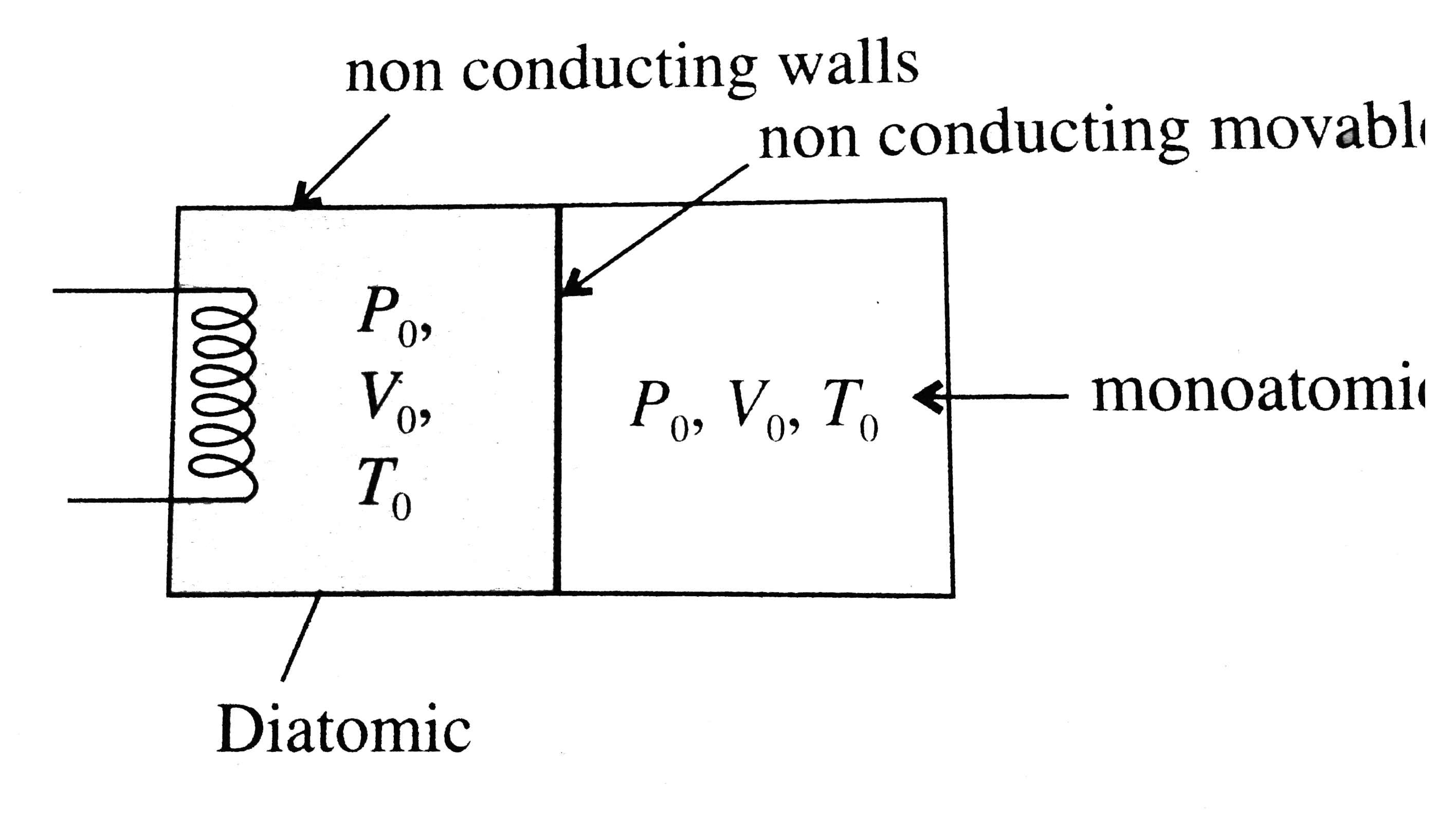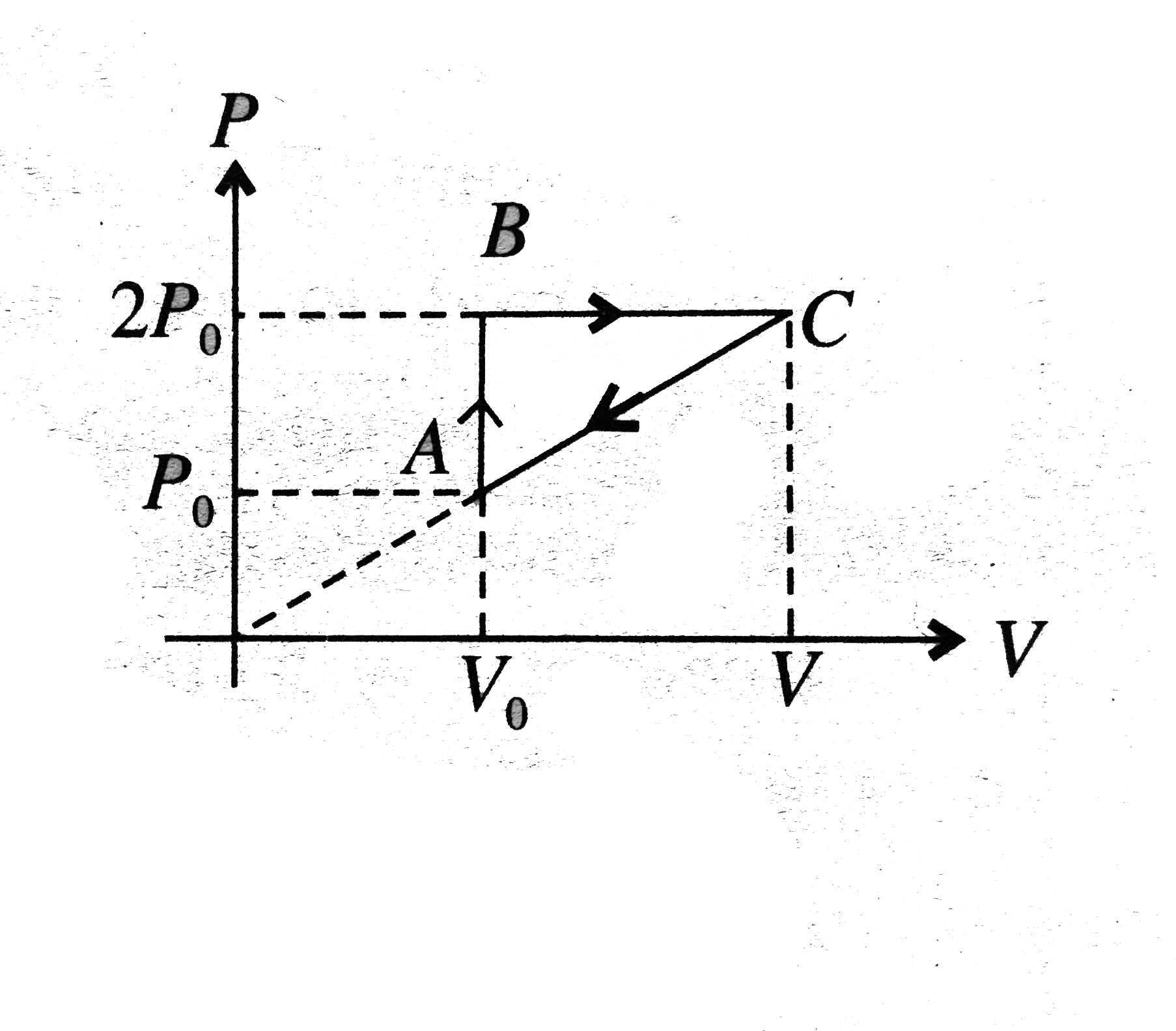Ten moles of a diatomic perfect gas are allowed to expand at constant pressure. The initial volume and temperature are V0 and T0 respectively. If 72RT0 heat is transferred to the gas, then the final volume and temperature are
(a) 1.1V0,1.1T0
(b) 0.9V0,0.9T0
(c) 1.1V0,1011T0
(d) 0.9V0,109T0
The correct Answer is:A
To solve the problem step by step, we will use the principles of thermodynamics related to ideal gases, particularly focusing on the heat transfer during an isobaric (constant pressure) process.
Step 1: Understand the Given Data
We have:
- Number of moles, n=10
- Initial volume, V0
- Initial temperature, T0
- Heat transferred, Q=72RT0
Step 2: Use the Formula for Heat Transfer
For an ideal gas undergoing an isobaric process, the heat transferred can be expressed as:
Q=nCpΔT
Where:
- Cp for a diatomic gas is 72R
- ΔT=Tf−T0 (where Tf is the final temperature)
Step 3: Substitute the Values into the Heat Equation
Substituting the values into the heat equation:
72RT0=nCp(Tf−T0)
72RT0=10(72R)(Tf−T0)
Step 4: Simplify the Equation
We can cancel 72R from both sides:
T0=10(Tf−T0)
Step 5: Solve for Final Temperature Tf
Rearranging the equation:
T0=10Tf−10T0
11T0=10Tf
Tf=1110T0=1.1T0
Step 6: Use the Ideal Gas Law to Find Final Volume
Since the process is at constant pressure, we can use the ideal gas law, which states that:
VT=constant
Thus, we have:
VfTf=V0T0
Step 7: Solve for Final Volume Vf
Substituting Tf:
Vf1.1T0=V0T0
This simplifies to:
Vf=1.1V0
Final Results
Thus, the final volume and temperature of the gas are:
- Final Temperature, Tf=1.1T0
- Final Volume, Vf=1.1V0
We have:
- Number of moles, n=10
- Initial volume, V0
- Initial temperature, T0
- Heat transferred, Q=72RT0
For an ideal gas undergoing an isobaric process, the heat transferred can be expressed as:
Q=nCpΔT
Where:
- Cp for a diatomic gas is 72R
- ΔT=Tf−T0 (where Tf is the final temperature)
Substituting the values into the heat equation:
72RT0=nCp(Tf−T0)
72RT0=10(72R)(Tf−T0)
We can cancel 72R from both sides:
T0=10(Tf−T0)
Rearranging the equation:
T0=10Tf−10T0
11T0=10Tf
Tf=1110T0=1.1T0
Since the process is at constant pressure, we can use the ideal gas law, which states that:
VT=constant
Thus, we have:
VfTf=V0T0
Substituting Tf:
Vf1.1T0=V0T0
This simplifies to:
Vf=1.1V0
Thus, the final volume and temperature of the gas are:
- Final Temperature, Tf=1.1T0
- Final Volume, Vf=1.1V0
Topper's Solved these Questions
- LAWS OF THERMODYNAMICSBOOK - DC PANDEY ENGLISHCHAPTER - LAWS OF THERMODYNAMICSEXERCISE - Level 2 More Than One Correct
6 Videos
- LAWS OF THERMODYNAMICSBOOK - DC PANDEY ENGLISHCHAPTER - LAWS OF THERMODYNAMICSEXERCISE - Level 2 Passage I
2 Videos
- LAWS OF THERMODYNAMICSBOOK - DC PANDEY ENGLISHCHAPTER - LAWS OF THERMODYNAMICSEXERCISE - Level 1 Subjective
24 Videos
- LAWS OF MOTIONBOOK - DC PANDEY ENGLISHCHAPTER - LAWS OF MOTIONEXERCISE - Medical entrances gallery
39 Videos
- MAGNETIC EFFECT OF CURRENT AND MAGNETISMBOOK - DC PANDEY ENGLISHCHAPTER - MAGNETIC EFFECT OF CURRENT AND MAGNETISMEXERCISE - Integer type Questions
10 Videos
Similar Questions
An ideal gas is found to obey the law V2T=constant. The initial pressure and temperature are P0 and T0. If gas expands such that its pressure becomes P04, then the final temperature of the gas will be
View SolutionA gas is found to be obeyed the law p2V=constant. The initial temperature and volume are T0andV0. If the gas expands to a volume 3V0, then the final temperature becomes.
View Solution
Knowledge Check
The ratio of the molar heat capacities of a diatomic gas at constant pressure to that at constant volume is
A75B32C35D52
An ideal gas has a specific heat at constant pressure Cp=5R2. The gas is kept in a closed vessel of volume V0 at temperature T0 and pressure p0. An amount fo 10p0V0 of heat is supplied to the gas.
(a) Calculate the final pressure and temperature of the gas.
(b) Show the process on p-V diagram.
View SolutionA cylindrical container having non-conducting walls is partitioned in two equal parts such that the volume of the each parts is eqaul to V0 A movable non-conducting piston is kept between the two parts. Gas on left is slowly heated so that the gas on right is compressed upto volume V0/8. Find pressure and temperature on both sides if initial pressure and temperature, were P0 and T0 respectively. Also find heat given by the heater to the gas (number of moles in each parts is n)

View SolutionA cylindrical container having non-conducting walls is partitioned in two equal parts such that the volume of the each parts is eqaul to V0 A movable non-conducting piston is kept between the two parts. Gas on left is slowly heated so that the gas on right is compressed upto volume V0/8. Find pressure and temperature on both sides if initial pressure and temperature, were P0 and T0 respectively. Also find heat given by the heater to the gas (number of moles in each parts is n)

View SolutionAt constant volume , pressure and temperature are related (T0= STP temp.)
View SolutionThree moles of an diatomic gas are in a closed rigid container at temperature T (in K). 1 mole of diatomic gas gets dissociated into atoms without appreciable change in temperature. Now heat is supplied to the gas and temperature becomes 2T. If the heat supplied to the gas is x(RT), find the value of x.
View SolutionThe equation of state for a gas is given by PV=ηRT+αV, where η is the number of moles and α a positive constant. The intinal pressure and temperature of 1 mol of the gas contained in a cylinder is P0 and T0, respectively. The work done by the gas when its temperature doubles isobarically will be
View Solutionn moles of a diatomic gas has undergone a cyclic process ABC as shown in figure. Temperature at a is T0. Find volume at C

View Solution
